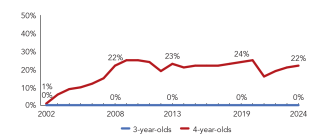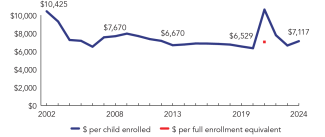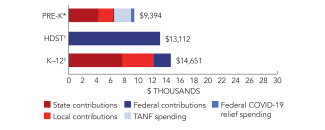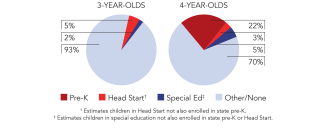
State of Preschool
North Carolina
Access Rankings
Resource Rankings
Total Benchmarks Met
Overview

During the 2023-2024 school year, North Carolina preschool enrolled 27,304 children, an increase of 1,620 from the prior year. State spending totaled $115,259,501 and $66,776,585 in TANF funds and $12,281,934 in federal recovery funds supported the program, up $23,807,791 (14%), adjusted for inflation, since last year. State spending per child (including TANF and federal relief) equaled $7,117 in 2023-2024, up $478 from 2022-2023, adjusted for inflation. North Carolina met 9 of 10 quality standards benchmarks.
What's New

The North Carolina Department of Health and Human Services (DHHS)/Division of Child Development and Early Education submitted a request and recommendation for adjustments to the FY 2023-2025 State Budget for NC Pre-K expansion to increase funding to account for inflation and cover the true cost of care. The Governor’s Budget Recommendations also included a proposal to keep North Carolina Pre-K viable and strong for North Carolina children and families by investing $197 million to provide adequate resources to recruit and retain qualified teachers at competitive salaries. Additional funds would increase reimbursement rates in all settings to cover the full cost of care and raise the administrative rate from 4% to 10%. Neither request was included, and no additional North Carolina Pre-K funding was provided in the FY 2023-2025 State Budget.
In September 2024, North Carolina was one of 10 states and D.C. awarded a 3-year federal renewal Preschool Development Grant B-5 (PDG B-5) totaling $9,000,000 annually. The PDG B-5 renewal grant is intended to carry out the strategic plans developed with the 2023 planning grants which focused on strengthening the NC early care and learning system by promoting family and community engagement, supporting early childhood workforce compensation and preparation, and enhancing training and coaching programs to promote workforce and early childhood social-emotional and mental health outcomes.
Background
North Carolina has provided state-funded pre-kindergarten education since 2001, originally via the More at Four Pre-Kindergarten Program. In 2011-2012, the program was renamed the North Carolina Pre-Kindergarten (NC Pre-K) Program, and administrative control moved from the Department of Public Instruction to the DHHS. NC Pre-K enrolls at-risk 4-year-olds from low-income families who have not participated in other early childhood programs. NC Pre-K programs are required to operate 6.5 hours per day for 36 weeks each year and serve as many eligible children as funding levels permit. Eligibility requires children to be in a household with income at or below 75% SMI, but up to 20% of children may be in a household with a higher income if they have another designated risk factor such as a developmental delay or identified disability, a chronic health condition, or limited English proficiency.
Funding for NC Pre-K includes state general appropriations and North Carolina Education Lottery receipts, federal funds, and a local contribution, with the majority of funding from the state. NC Pre-K classrooms operate statewide in settings such as privately licensed Head Start programs, childcare centers, and public schools. All programs, whether in public or private settings, must earn high quality ratings under the state child-care licensing system to participate in NC Pre-K and the state’s subsidy system. NC Pre-K sets a maximum class size of 20 four-year-olds and requires a staff-child ratio of 1:10. Lead teachers must have a bachelor’s degree and hold or be working towards a birth-through-kindergarten license. Classroom staff are required to use approved curricula and formative assessments aligned with the state’s early learning standards. Staff conduct ongoing formative assessments to gather information about each child’s growth and skill development, as well as to inform instruction.
North Carolina Pre-Kindergarten Program
Access
Resources
| Total state pre-K spending | $194,318,020 |
| Local match required? | Yes |
| State Head Start spending | $0 |
| State spending per child enrolled | $7,117 |
| All reported spending per child enrolled* | $9,394 |

*Pre-K programs may receive additional funds from federal or local sources that are not included in this figure. †Head Start per-child spending includes funding only for 3- and 4-year-olds. ‡K–12 expenditures include capital spending as well as current operating expenditures.
North Carolina Quality Standards Checklist
| Policy | Requirement | Benchmark | Meets Benchmark? |
|---|---|---|---|
For more information about the benchmarks, see the Executive Summary and the Roadmap to State pages. | 9*benchmarks met | ||
| Early Learning & Development Standards Benchmark | Comprehensive, aligned, supported, culturally sensitive | Comprehensive, aligned, supported, culturally sensitive | |
| Curriculum Supports Benchmark | Approval process & supports | Approval process & supports | |
| Teacher Degree Benchmark | BA* | BA | |
| Teacher Specialized Training Benchmark | ECE, CD | Specializing in pre-K | |
| Assistant Teacher Degree Benchmark | CDA or AA in ECE or CD | CDA or equivalent | |
| Staff Professional Development Benchmark | 5-20 hours/year; PD plans; Coaching | For teachers & assistants: At least 15 hours/year; individual PD plans; coaching | |
| Maximum Class Size Benchmark | 20 (4-year-olds) | 20 or lower | |
| Staff to Child Ratio Benchmark | 1:10 (4-year-olds) | 1:10 or better | |
| Screening & Referral Benchmark | Vision, hearing, health & more | Vision, hearing & health screenings; & referral | |
| Continuous Quality Improvement System Benchmark | Structured classroom observations; Data used for program improvement | Structured classroom observations; data used for program improvement | |
* Indicates that while policy meets the benchmark, it is not being implemented fully
